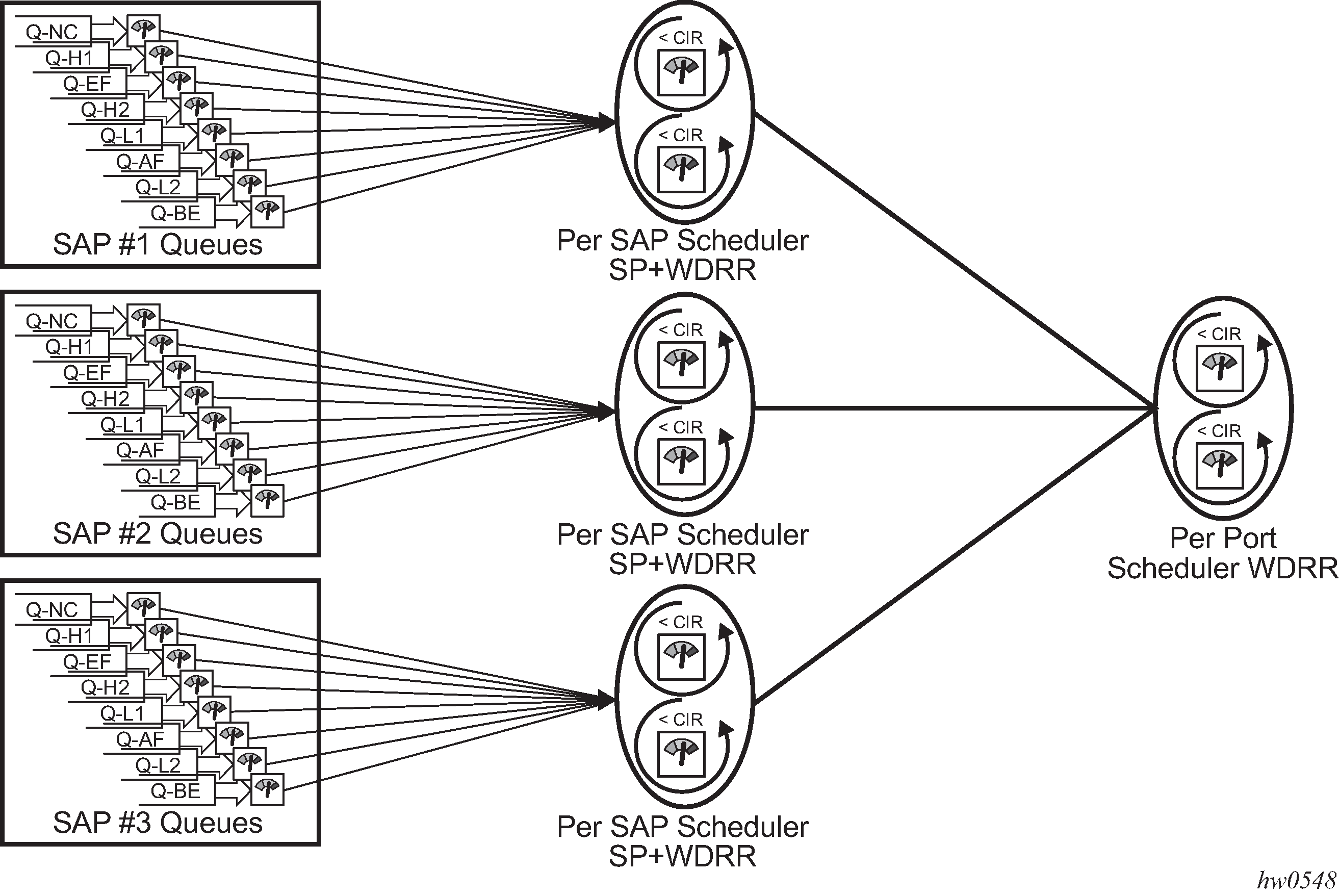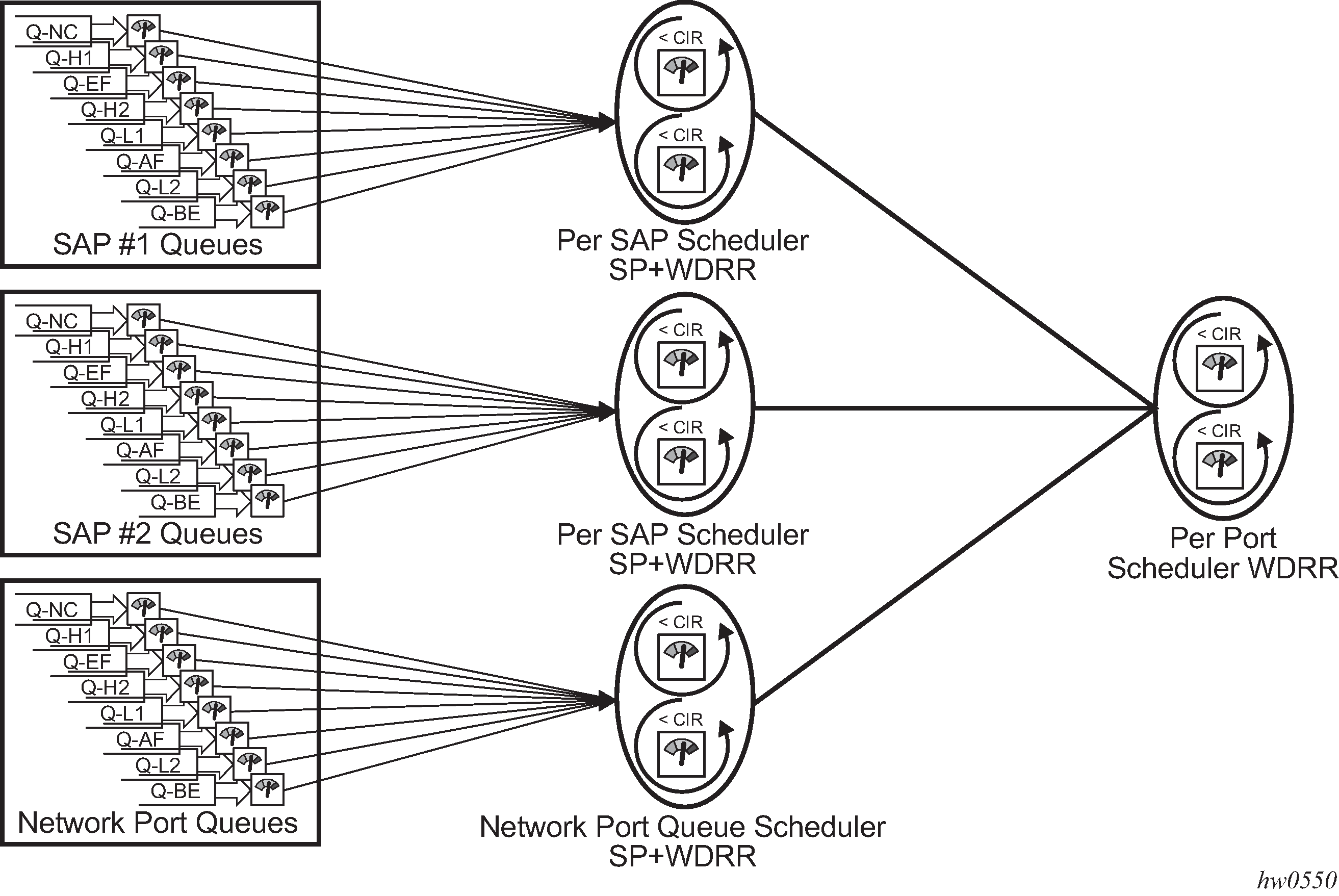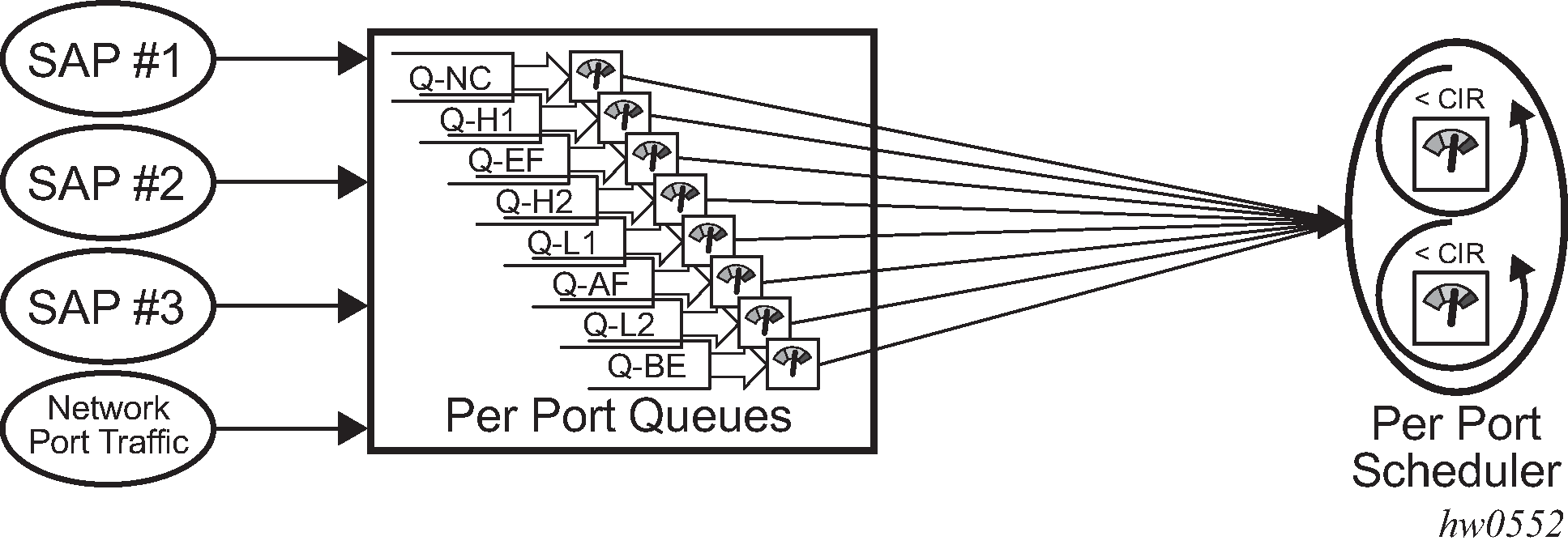Schedulers on 7210 SAS-R6 and 7210 SAS-R12
This chapter provides information about the scheduler support available on the 7210 SAS-R6 and 7210 SAS-R12 devices for network ports and SAPs.
See Service ingress QoS policies, Service egress policies on 7210 SAS-Mxp, 7210 SAS-R6, and 7210 SAS-R12, and Network queue QoS policies for more information about the configuration examples for scheduling parameters.
Scheduling with SAP-based queues on access ports
The following figure shows the scheduling for access ports when SAP-based scheduling is enabled, with multiple SAPs configured and when the port-scheduler-mode is disabled. There are eight egress queues per SAP, a per-SAP scheduler, and a per-access-port scheduler.

Each FC or queue of the port can be shaped to configured rates (CIR and PIR). This is used to control the amount of bandwidth allocated to the FC or queue.
FC-to-queue mapping is system-defined and not user configurable.
The queue number determines the priority of the queue. Priority of the queue is used only when the queues are configured as strict. Queue 8 is the highest priority and queue 1 is the lowest priority.
On the 7210 SAS-R6 and 7210 SAS-R12, only unicast traffic sent out of RVPLS SAPs uses per-SAP egress queues. BUM traffic sent out of RVPLS SAPs uses per-port egress queues. These per-port egress queues are not shown in SAP egress scheduling. There are eight per-port queues, which compete with per-SAP queues for bandwidth.
A queue can be defined to operate in strict mode or weighted mode. The queue mode determines the order of scheduling by the port scheduler.
In a CIR loop, scheduling is packet-based round-robin with a weight of 1.
The scheduler for an access port has the following behavior:
The per-port scheduler is available and works at line-rate or configured port egress rate.
The port scheduler distributes the bandwidth available to all the SAPs using WDRR scheduling mechanism (that is, all SAPs have equal weights assigned by the system).
The port scheduler uses the following two passes to distribute bandwidth across SAPs:
CIR loop
The port scheduler distributes the available bandwidth to all the SAPs in round-robin order, up to the configured CIR rate (CIR is configured in the aggregate shaper rates for the SAP).
PIR loop
The port scheduler distributes the remaining bandwidth (the bandwidth available after the CIR loop) to the all the SAPs in round-robin order (all SAPs are assigned equal weights by the system), up to the configured PIR rate (PIR is configured in the aggregate shaper rates for the SAP).
Each SAP has a per-SAP scheduler that operates in SP + WDRR mode and an aggregate per-SAP shaper (CIR/PIR). The per-SAP scheduler distributes the available bandwidth to the configured strict and weighted SAP queues, using the configured mode and rates, in two passes: CIR loop and PIR loop.
The CIR loop distributes the available bandwidth (from the bandwidth allocated to it by the port scheduler) to all the queues in the following order:
higher priority strict queues receive bandwidth up to the configured CIR
any remaining bandwidth, if available, distributed among the lower priority strict queues, up to the configured CIR
any remaining bandwidth, if available, distributed among the weighted queues (in the CIR loop, weights are not used and therefore the bandwidth is distributed in equal proportion irrespective of weights configured)
The PIR loop distributes the remaining bandwidth (the bandwidth remaining after CIR loop) to all the queues in the following order:
higher priority strict queues receive the bandwidth, up to the configured PIR
any remaining bandwidth, if available, distributed among the lower priority strict queues, up to the configured PIR
any remaining bandwidth, if available, distributed among the weighted queues in proportion to their configured weights
Each queue can be configured with a queue-mode (strict or weighted) and is associated with a shaper (which allows users to configure CIR and PIR). The queue mode determines the order of scheduling by the SAP scheduler and shaper rate controls the amount of bandwidth used by the queue.
Scheduling on network ports
For a network port, the scheduling behavior is similar to Scheduling with SAP-based queues on access ports, except that a per-SAP scheduler is not present in the hierarchy. Instead, the per-port scheduler distributes the available port bandwidth to all the queues configured on the port in two passes using similar behavior to the per-SAP scheduler. Additionally, all traffic sent out on the network port uses a set of eight queues that are mapped to the eight forwarding classes. The following figure shows this behavior.

Scheduling on hybrid port with SAP-based egress queues
The following figure shows the scheduling hierarchy for hybrid ports with both SAPs and network interfaces configured.

The scheduling behavior is similar to the SAP-based queues on the access ports. The network port queues used for network traffic are treated like a SAP node in the scheduling hierarchy.
Port-based scheduling and queuing on access ports
When port-scheduler mode is enabled, traffic sent out of SAPs configured on access ports and hybrid ports, share a set of eight egress queues that are mapped to the eight forwarding classes. A per-port scheduler (similar to the one available for network port) distributes the available port bandwidth to all the queues configured on the port in two passes using similar behavior to the per-SAP scheduler.
The per-SAP scheduler is not present in the scheduler hierarchy when port-scheduler mode is enabled.
The following figure shows the port-based scheduling and queuing enabled on access ports on the 7210 SAS-R6 and 7210 SAS-R12.

Port-based queuing and scheduling on access ports has the following behavior:
If enabled, all SAPs on the node use port-based queuing. This means that the user has an option to use either SAP-based queues for all SAPs configured on the node, or port-based queues for all SAPs configured on the node. A mix and match of some SAPs using port-based queues and some SAPs using SAP-based queues is not supported
All SAPs on an access port share the eight egress queues on the port. On hybrid ports, SAPs use network port queues, which means that, on hybrid ports, all the SAPs configured on the port and the network port IP interfaces share the eight egress queues on the port.
This functionality supports two-level hierarchical shaping, with per-queue shaper and per-port aggregate shaper (ERL).
Each FC or queue of the port can be shaped to configured rates (CIR/PIR). This is used to control the amount of bandwidth allocated to the FC or queue.
FC-to-queue mapping is system-defined and not user configurable.
The queue number determines the priority of the queue. Priority of the queue is used only when the queues are configured as strict. Queue 8 is the highest priority and queue 1 is the lowest priority.
A queue can be defined to operate in strict mode or weighted mode. The queue mode determines the order of scheduling by the port scheduler.
The scheduling behavior is similar to the scheduling behavior that is supported on SAPs with the following modifications:
Each access port has a per-port scheduler that operates in SP + WDRR mode and an aggregate per-port shaper (ERL). The per-port scheduler distributes the available bandwidth to the configured strict and weighted queues, using the configured mode and rates, in two passes: CIR loop and PIR loop.
The CIR loop distributes the available bandwidth to all the queues in the following order:
Higher priority strict queues receive bandwidth up to the configured CIR.
Any remaining bandwidth, if available, is distributed among the lower priority strict queues up to the configured CIR.
Any remaining bandwidth, if available, is distributed among the weighted queues (in the CIR loop, weights are not used and therefore the bandwidth is distributed in equal proportion irrespective of weights configured)
The PIR loop distributes the bandwidth remaining after CIR loop to all the queues in the following order:
Higher priority strict queues receive the bandwidth, up to the configured PIR.
Any remaining bandwidth, if available, is distributed among the lower priority strict queues, up to the configured PIR.
Any remaining bandwidth, if available, is distributed among the weighted queues in proportion to their configured weights.
Scheduling on hybrid port with port-based SAP queues
The following figure shows the scheduling hierarchy for the hybrid port, with SAPs using port-based queues and network IP interfaces using port-based queues. The scheduling behavior is similar to that of an access port when port-based queues are used (as described previously).
